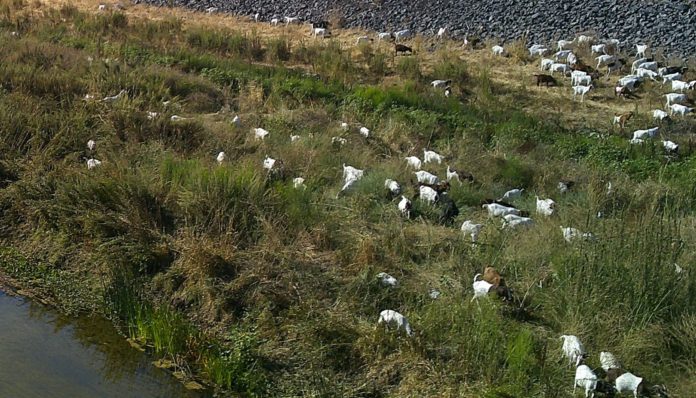By Jack Alcorn
In early July a herd of 400 goats arrived on the north shore of Alameda Creek, east of the Isherwood causeway from Paseo Padre into Quarry Lakes Recreation Area.
Prescribed grazing is a nature-based wildfire mitigation tactic. Livestock are employed to manage excess grass and brush in undeveloped areas. This innovative approach to reducing wildfire risk allows cattle, sheep or goats to feed freely in designated fields.
Wildfires have impacted over 5 million acres of California open space in the past 5 years. Second only to automobiles and other transportation, wildfires are the second highest emitter of climate warming greenhouse gasses.
Prescribed grazing involves the careful movement of grazing livestock over areas at high risk for burning. The popular land management practice cultivates a balanced ecosystem and restores native plant and habitat species.
California Climate Agriculture Network, California Woolgrowers Association, ranch owners, East Bay Regional Park District, and CA Department of Conservation are some of the many agencies working collaboratively to bring this eco-friendly wildfire solution to California communities.
Prescribed grazing converts vegetation into food. It naturally recycles nutrients and removes combustible grass and brush from the landscape. The practice is more effective and more cost efficient than the two most common vegetation management alternatives – mowing equipment and chemical herbicide treatments. Mowing or burning costs up to $5,000 per acre annually. Grazing costs $500 – $1000 per acre.
Grazing replaces controlled burns. Burning vegetation to reduce fire risk mars the landscape and emits soot, sulfur, greenhouse gasses and other environmental contaminants.
Grazing allows livestock to naturally fertilize the land without burdening any one location with excess manure. This increases soil fertility and improves forage health, removing invasive species. Native, perennial, and other desired plants are more able to thrive.
A growing number of cities, counties, fire safe councils, and homeowners associations are using prescribed grazing as a wildfire risk reduction tool. CalFire and the California Department of Conservation offer several grant programs for ranchers and communities to implement grazing operations. East Bay Regional Park District targets 960 acres for grazing annually in parklands across Alameda and Contra Costa counties.
Peak grazing season is March thru September. To view the grazing goats visit the Isherwood Staging Area, Quarry Lakes Recreation Area, Fremont. The goats are consuming more than 3,000 lbs of foliage per day over a 300 acre stretch of Alameda Creek. The hungry herd of mostly white goats and some sheep will grow to 600 before removal in October.







